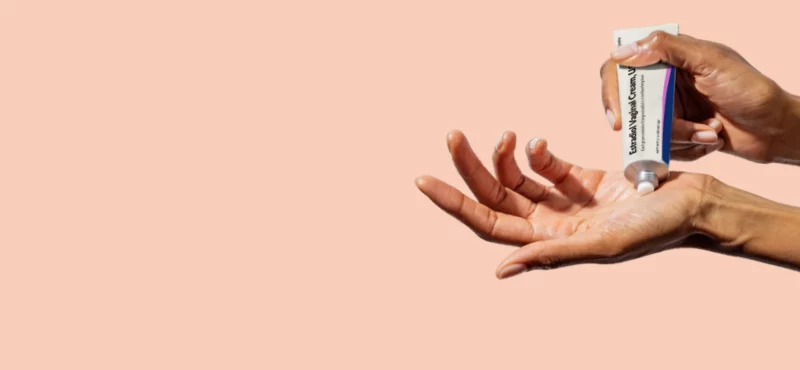Menopause and yeast infections are not an ideal combination, but a very common one. Around the time of menopause, women can experience an increase in vaginal yeast infections and also other infections like bacterial vaginosis and UTIs. You may also notice low estrogen symptoms like vaginal dryness, itching, or burning that seems like a yeast infection.
Our medical team is here to explain what we know about yeast infections, what causes yeast infections, and which treatments are likely to help cure a yeast infection. And if you would like prescription treatment, we offer an easy online telehealth consult to get you feeling better quickly, along with preventative treatments to support your health in the future.
What is a yeast infection?
A yeast infection happens when there is an overgrowth of the yeast called Candida. It’s normal for the vaginal environment to contain Candida, but when there is too much of it, it can turn into an uncomfortable infection.
Yeast infection symptoms include:
- Pain when you pee
- Red, swollen vaginal tissue
- Itching and soreness around your vagina
- White vaginal discharge that looks like cottage cheese
Does menopause cause yeast infections?
Menopause is a time of declining estrogen levels that can lead to significant changes to the vaginal environment like vaginal dryness, itching, burning, urgency to pee, and frequent UTIs. The medical term is vaginal atrophy or the genitourinary syndrome of menopause. Symptoms can start in your 30s and 40s in the perimenopause years and get worse with time. The good news is it's highly treatable.
When estrogen levels decline, the good bacteria that protect your vagina from infection start to decline. This can lead to an overgrowth of some organisms - like the Candida fungus that causes yeast infections. Other vaginal infections like bacterial vaginosis and UTIs are also common.
How do I get rid of a yeast infection?
Fortunately, yeast infections are easy to cure with over-the-counter remedies or with prescription medication.
The best way to get rid of a yeast infection quickly (and spend less money on ineffective yeast infection remedies) is to get help from a board-certified doctor, such as a doctor here at Interlude.
There is no single best treatment for yeast infection, but most doctors will prescribe an antifungal medication like fluconazole (Diflucan). Fluconazole is a single oral pill that you can take to cure a yeast infection completely. You’ll start to notice improvement within 24 hours or less. Fluconazole is not available over-the-counter, so you’ll need a prescription. But we make that part super easy with a same-day online consult and prescription through Interlude.
The over-the-counter option for yeast infections is Monistat which is a vaginal suppository or vaginal cream that you insert into your vagina. If you are dealing with a first-time infection, Monistat is just as effective as fluconazole. However, you’ll need to use Monistat daily for seven days, so it’s a little less convenient than a single pill for yeast infection, like fluconazole.
How to prevent yeast infections
If yeast infections keep coming back, or if your vagina is still itchy and dry, then you may need to try a different strategy.
If you’re in perimenopause, menopause, or beyond, then topical vaginal estrogen is one option to consider. At Interlude, our board-certified doctors offer it as an estradiol vaginal cream or estradiol vaginal suppository. Topical vaginal estrogen works by adding a small amount of estrogen directly back to the vaginal tissues. Applied vaginally about twice weekly, it can help restore vaginal moisture and vaginal pH to healthy levels and protect your body from vaginal infections.
You can also try vaginal moisturizers or lubricants. The idea behind a good moisturizer or lubricant is that it can protect your vaginal skin from abrasions which might trigger yeast. However, sometimes the skin can be so thin and dry that prescription treatment like estradiol vaginal cream is the only adequate solution.
As we mentioned before, you can take fluconazole as a one-time treatment for yeast infections. But you can also take fluconazole as a maintenance dose to prevent yeast infections. You can even take it for years if needed.
Boric acid, which you can get over-the-counter as a vaginal suppository, is also an option. When fluconazole or Monistat fails to adequately cure a yeast infection, you can instead insert a boric acid suppository daily for up to two weeks to help clear the infection.(1)
Probiotics seem like a great way to prevent yeast infections since many manufacturers promise they will restore protective bacteria to the vaginal environment. But so far, research has shown that vaginal probiotics are not effective against yeast infection.(2)
Lastly, antibiotics should never be used to treat vaginal yeast infections. At Interlude, we offer antibiotics for bacterial vaginosis and antibiotics for UTIs, but these treatments are not meant for yeast infections.
Does estrogen cause yeast infections?
You may notice an increase in yeast infections if you are taking topical vaginal estrogen or systemic hormone replacement therapy (HRT). If this happens to you, you can quickly cure the infection with a prescription pill like fluconazole, and then talk to your doctor. They might recommend that you reduce your dose of topical vaginal estrogen or systemic HRT.
Yeast infection vs UTI
A yeast infection is different from a UTI. UTIs happen when bacteria sneak up into the urethra and bladder and cause infection.
UTI symptoms include:
- Burning when you pee
- Blood in your urine
- Pain in your abdomen
- Pain in your lower back
- Vomiting or nausea
Frequent UTIs are common during menopause, and if you have a UTI, you should take antibiotics like nitrofurantoin (Macrobid) to clear the infection and prevent complications. For many women in perimenopause and beyond, antibiotics alone will not treat the underlying cause of low estrogen and the UTI will keep coming back. In this case, estradiol vaginal cream or estradiol vaginal suppositories can treat the root cause and help prevent UTIs from coming back.
Yeast infection vs BV
A yeast infection is different from bacterial vaginosis (or BV). Bacterial vaginosis happens when bad bacteria dominate the good bacteria in the vaginal environment.
BV symptoms include:
- Fishy vaginal odor
- Thin grey vaginal discharge
- Itching and burning
BV is common during menopause and you can take antibiotics to clear the infection. But most of the time, BV infections will come back. The high rate of repeat BV infections underscores the importance of protective bacteria in the vaginal environment. Estradiol vaginal cream or estradiol vaginal suppositories can help restore the protective bacteria in the vaginal environment and prevent future infections. Probiotics may also be helpful.
Conclusions and next steps
Hormones influence the vaginal environment from birth to menopause. When dealing with yeast infections in menopause, it’s essential to consider the underlying cause of infection, dryness, irritation, and pain. And remember, you’re probably not doing anything wrong. Your body is just producing less estrogen and this can lead to infections like yeast overgrowth, UTIs, and BV.
In most cases, fluconazole can quickly clear a yeast infection. Probiotics won’t hurt, but they probably won’t help. Avoid completely any unproven products that can make things worse. And to address the underlying changes to the vaginal environment due to low estrogen, we offer estradiol vaginal cream or estradiol vaginal suppositories.
Dealing with vaginal and urinary changes during perimenopause and menopause can be overwhelming. But it doesn’t have to be. Our board-certified doctors are here to help. And if you’re not sure where to start, browse our treatment options, take our quiz, or learn about how our online consults work.



